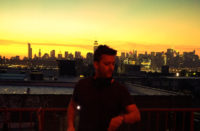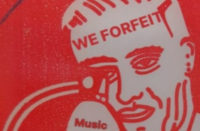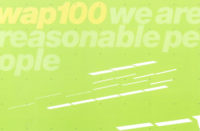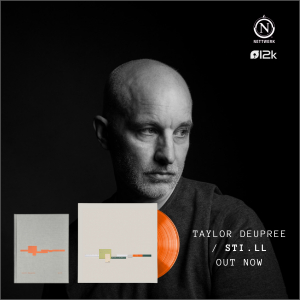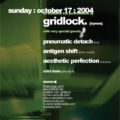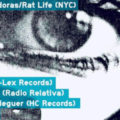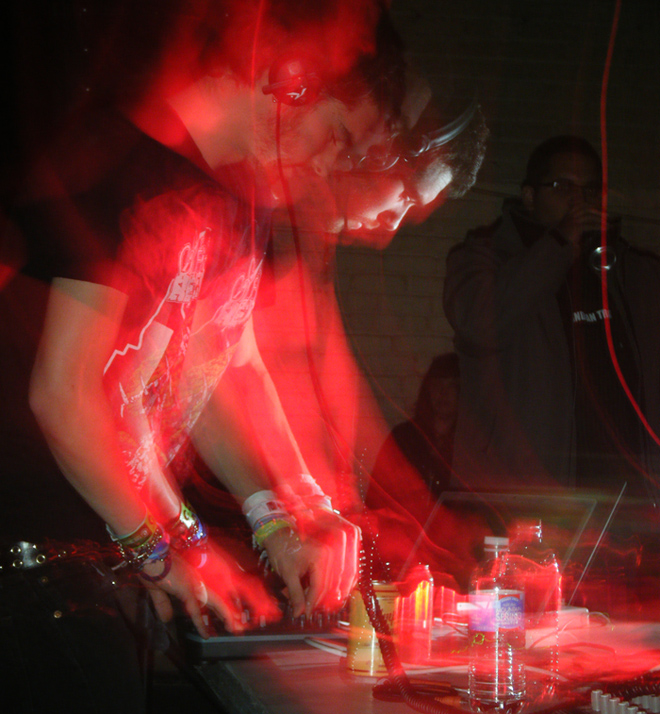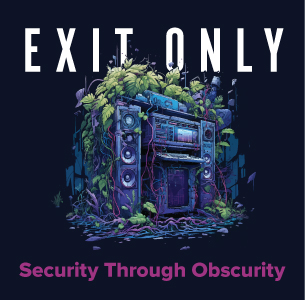Justin Patrick Moore‘s Negativland with Sue-C show review and Stand By for Failure Documentary double feature.
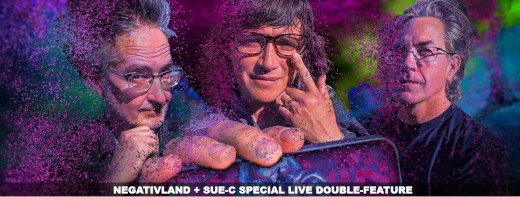
Negativland tour, a cause for a pilgrimage
I have tried as best I might to not fall prey to the middle-aged habit of going to see eighties nostalgia acts. Going to see Negativland, I have kept my word to myself, even as Mark Hosler announced from the stage towards the end of the show, “we are an eighties band.” Yes, they did have their start then, at the end of the seventies as the infinite game of the cold war continued to rage with all the same fizz and ferocity as the battle between Coke and Pepsi. But “the band” has never been just an eighties act. They don’t even call themselves a band most of the time, but a collective. They have been a collective of the decades and for the decades, even if now some of the members now only exist as digitized tape. The only thing static about Negativland has been the static picked up by the radio receivers they have routinely used as one of their many mediated sound sources. All of these things make a Negativland tour a cause for a pilgrimage. Lucky for me I only had to drive an hour and a half south of my domicile to Lexington, Kentucky for an evening of outlaw sonification and the screening of the strangest biopic rockumentary in the annals of art house cinema.
Kentucky is one of the most beautiful states in all the union, and I have family from the state and in Lexington, so I went down early to visit when the fated day of June 10th arrived. After my family visits I made my way from a home near the Keeneland horse racing track to the gorgeous Kentucky Theater in the heart of downtown. At 102 years old, the theater was a pleasure to behold, though I was a bit sad their grand marquee hadn’t declaimed the presence of Negativland to all and sundry. The place was opulent in the best possible way, and showcases how far our tastes have fallen as a society where cheap buildings filled with so-called luxury loungers play bad movies filled with product placements. A marble concession stand sat inside a gilded hall resplendent with mirrors, chandeliers and movie posters from before the time when everything was just another franchise, from a before a time when everything was owned by Disney-Marvel-Lucasfilm. (I’m still waiting for that corporate force to release a very bad mash-up featuring a light saber wielding Scrooge McDuck and his side-kick Wolverine battling Darth Vader. Nah, never mind, just gimmee the mermaid.)
The setting made the Negativland set all the more enjoyable, but before they played, they screened the recent documentary by Ryan Worsley on their lives and work, Stand By For Failure. I was relieved that the only musicians, or not-musicians as the case may be, in this documentary were members of Negativland. There was nobody from Matmos or People Like Us coming onto the screen to explain just how very important the albums A Big 10-8 Place, Points, or Helter Stupid are. Bono and The Edge were thankfully entirely absent from talking about the collective that made their music famous. It was just Negativland, and it was very personality centric as it zoomed in on members of the collective. Giving voice to their personalities gave insight into the way each of them put their own highly personal approach to creativity into all the different projects they’ve done as a group. It accomplished this all while completely avoiding any talk about things such as songwriting, collecting samples, or how they actually make their records in the studio.
Ryan Worsley has worked directly with Negativland for a number of years now. She was also the force behind the 2017 documentary How Radio Isn’t Done about the late member Don Joyce’s pioneering radio work on the Negativland related Over The Edge program on KPFA (now hosted by member Wobbly / Jon Leidecker). After that she created music videos for tracks from the pair of albums True False and The World Will Decide, were released in 2019 and 2020. Her work on the video for new classic “More Data” gives a taste for abilities as a visual editor and collagist.
At this point members of Negativland felt like Worsley was a part of the collective, that when she approached them about making a documentary they gave her complete unfettered access to their archives, and said have at it. It’s an approach that makes sense for a group whose own work has been based on plundering the media archives of our collective culture. Their own archives included the hours and hours of home movies recorded by the David Wills, aka the Weatherman. Fans of the band of will be very familiar with the Weatherman’s home tapes he recorded from his earliest years, and has used on albums and many Over the Edge programs such as the Willsaphone Stupid Show. These home movies not only went back to the Weatherman’s youth, but went all the way up to the present. In one clip, Don Joyce and others had gone over to his house and, after the shoe cleaning ritual, they sat down in the living room as the Weatherman tried to load up a page on the internet. It looks like it must be in the nineties when this is happening. Don Joyce comments on how “the internet is dumb.” As much good as the internet can do, at this point in time I think I’d much rather have a Universal Media Netweb instead.
“What sounds were real, and what sounds were merely recordings of sounds was somewhat hard to decipher, in a manner similar to trying to determine if a person chatting with you online is really a person or is actually just a bot.” ~Justin Patrick Moore
People who’ve seen the No Other Possibility VHS tape will recognize some of the footage used in Worsley’s documentary; but there is much else besides that she has tapped into to make her own collage. The music is all from Negativland or Over The Edge shows, so you know the audio is going to be great. The film becomes very poignant as three members of the collective age and pass away. First Ian Allen, then Richard Lyons, and finally Don Joyce. The footage of the Weatherman in the hospital with Richard was very touching, and the news clips about how negative it was of the group to ship little baggies with two grams of the cremains of Don Joyce alongside copies of their Chopping Channel album to fans continues to amuse.
One of the great things for me about this documentary, and about Negativland in general, is how much radio has been involved in what they do. Getting to see the Weatherman’s goth-space music set up with and all the radio scanner and gear he uses was priceless. The footage of his mom shaming him for eavesdropping via these scanners onto peoples baby monitor’s was priceless. So many antennas, so many radios, so many microphones, even crystal ones, so many tapes.

A slice -or splice- of wonder ::
Following the end of the movie, the receptacle portion of the program ensued with Mark Hosler and Jon Leidecker taking questions from the audience. During a question about the matching of the music with the movie, Mark mentioned how Ryan Worsley could edit video as fast as she thought. The way the film was put together through extensive recycling and reuse of their own material made it feel like another media extension of their collective mind. This first half of the double feature was a slice -or splice- of wonder, something much needed in a world where people don’t really know wonder as much as they might. The congenial and friendly audience during the intermission only added to the positive feeling that we were all really there together.
The fact that we were there became important as the live set got underway, because it posed many questions about reality and our virtual online spaces, the biggest being: Do Alternative Reality Games Lead to Alternative Reality Elections? At this point it should be noted that, like the prog rock albums that were an influence on Mark Hosler, every Negativland album is based around a concept. This concert was no different in that respect, and the material played will be forming the basis for their next record. It was like being uploaded into a bit-mapped cloud of virtuality. What sounds were real, and what sounds were merely recordings of sounds was somewhat hard to decipher, in a manner similar to trying to determine if a person chatting with you online is really a person or is actually just a bot.
Negativland have always used samples from all across media sources to tell a story. The sources they used in their earlier work came off the radio, were found in old films, on TV and tapes and records bought at the thrift store. Now they are sampling as much from YouTube video-game channels, live voice chats and other internet-based sources as anything else. If one listens with care it can also be discerned that they have been making use of voice synthesis programs to make their own samples, getting the program to say things that sound odd, because they get them to say phrases in ways humans normally wouldn’t normally talk. They use these tools to make voices say things that might not otherwise be said. All of this got thrown into the web they weaved, with a focus on video games, the games we play with each other, and the way that what happens in games ends up leaking out into our shared society. 8-bit arcade sounds formed part of the musical bedrock for these digital assaults.
The video portion of the show was created and manipulated live by Sue-C. Though she wasn’t there, it felt like she really was by way of her being linked up to the show and her video feed projected onto the screen of the movie theater. She did a lot of work using her hands and what seem to be the kind of projectors that people might remember from school, overlaid with other collaged video work. This visual component was in many ways as edited and chopped as the audio component. All in all, it was a feast for the senses. Some might feel this kind of thing to cause over stimulation, whereas people like me tend to use it is a way of coping with and understanding the overstimulation already present in a highly saturated media environment.
One song was all about the main objective of many video games: killing all the other living things in the game. Shooting them dead. Making sure you, as a first person shooter, were the only person left alive at the end of the game. A very brief excerpt from their Guns EP was resampled and injected as an insert cut into the flow of this bullet laden barrage. That little projectile of a sample was enough to alert dedicated listeners that we were exploring one of the themes the band has returned to again and again, this time through the sharp shooting angle of Nintendo, Playstation, and Xbox.
Images of Spider-Man and his nemesis Venom appeared on the screen along with others as they wreaked havoc in this binary digital world. Here they remind us of the true or false nature of our divided suppositions, yet they both have no problem eating at McDonald’s. People need to load up on Big Mac’s before they can really get into attack mode after all, because “when you fire it will die.”
My favorite things from the visual component (besides all the crafty real-time hand manipulation) were the images of a virtual amusement park that showed rides crashing into other people as they walked around or waited in line. This is very reminiscent of the gaming world and our world in general, where one person’s sense of fun is bought and paid for at the expense of another. Cars and their crashing into each other also made an appearance on the screen, accompanied by the sound of the Cadillac sample used on the song “Cadillac” from TrueFalse (taken from one of late member Ian Allen’s old tapes). This part of the show recalled another perennial themes from Negativland: American car culture as also exemplified on the album Free in tracks like “City Man” and “We Are Driven.”
In our current gamified economy it might be useful to ask some other basic questions. Such phrases as “why can’t you find a job?” and “who still has a job?” came over the loudspeakers. Later in the set this subject was recycled with samples about how “apparently people are working harder and getting paid less.” This is useful to know because many of these gaming platforms you can get an account going for free, and you can even make money by playing games. I also learned how “you don’t have to pay people to participate” but sometimes you still have to pay to play. If that fails, however (and collective financial failure does seem imminent) you could just sell off your digital assets.
Sometimes the questions their music raises might make you feel like a non-player character in your own life. But it also might give you the moxie to bite back, to refuse to give any more of your agency and autonomy away to the corporate state. Or it might just want to make you go outside and play with your friends. As humans we face so many predicaments, many of our own making. A predicament is different than a problem. Problems can be solved. Predicaments are things that we all get stuck in. One of the voices they used tells us that “violating trust is the easiest way to solve the problem.”
A predicament is different than a problem ::
They closed the show with just one nod to nostalgia, doing a rendition of a beloved classic from one of their albums from the eighties. This was followed by a live video check-in to the home of the Weatherman in Seattle, where he played a very short set using a number of radios. The Weatherman gave the useful pro tip that you can make electronic music with as little as two radios. It was a pleasure to visit with him live in real time, and to hear him try to enunciate the name of the city Lex-ing-ton.
Negativland continues to play the long game. Perhaps they are even playing the infinite game. It’s a game of cultural remediation. The questions they pose just might be the answers and offer a kind of remedy and reversal to our damaged and untrustworthy media ecosystems. At the same time they give us the freedom to choose for ourselves what it all means. They’ve put the dots out on the screen and in the audio field. It’s up to us to connect them. I’m not sure I’ve settled on any definitive answers just yet. That will be left up to the world to decide.
The current tour is on hiatus for the rest of June, but continues on the last day of July and into August with dates for the early fall being scheduled. Check out their website and Facebook page for current info on where they will be next. If they are not nearby, it is really worth the pilgrimage!
Stand By For Failure is out now.






